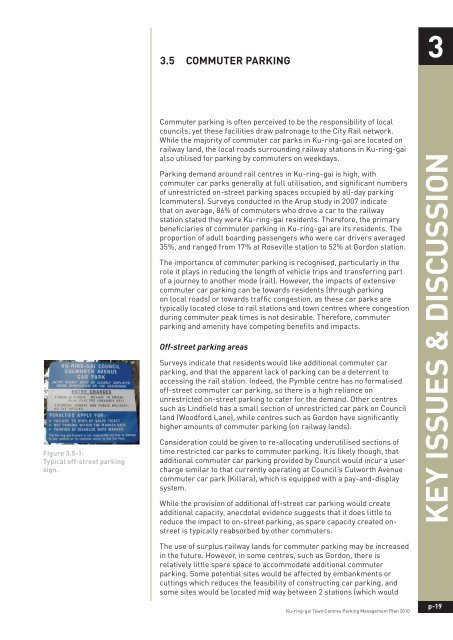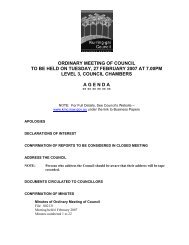pdf. 4MB - Ku-ring-gai Council
pdf. 4MB - Ku-ring-gai Council
pdf. 4MB - Ku-ring-gai Council
You also want an ePaper? Increase the reach of your titles
YUMPU automatically turns print PDFs into web optimized ePapers that Google loves.
3.5 COMMUTER PARKING<br />
3<br />
Figure 3.5-1:<br />
Typical off-street parking<br />
sign.<br />
Commuter parking is often perceived to be the responsibility of local<br />
councils, yet these facilities draw patronage to the City Rail network.<br />
While the majority of commuter car parks in <strong>Ku</strong>-<strong>ring</strong>-<strong>gai</strong> are located on<br />
railway land, the local roads surrounding railway stations in <strong>Ku</strong>-<strong>ring</strong>-<strong>gai</strong><br />
also utilised for parking by commuters on weekdays.<br />
Parking demand around rail centres in <strong>Ku</strong>-<strong>ring</strong>-<strong>gai</strong> is high, with<br />
commuter car parks generally at full utilisation, and significant numbers<br />
of unrestricted on-street parking spaces occupied by all-day parking<br />
(commuters). Surveys conducted in the Arup study in 2007 indicate<br />
that on average, 86% of commuters who drove a car to the railway<br />
station stated they were <strong>Ku</strong>-<strong>ring</strong>-<strong>gai</strong> residents. Therefore, the primary<br />
beneficiaries of commuter parking in <strong>Ku</strong>-<strong>ring</strong>-<strong>gai</strong> are its residents. The<br />
proportion of adult boarding passengers who were car drivers averaged<br />
35%, and ranged from 17% at Roseville station to 52% at Gordon station.<br />
The importance of commuter parking is recognised, particularly in the<br />
role it plays in reducing the length of vehicle trips and transfer<strong>ring</strong> part<br />
of a journey to another mode (rail). However, the impacts of extensive<br />
commuter car parking can be towards residents (through parking<br />
on local roads) or towards traffic congestion, as these car parks are<br />
typically located close to rail stations and town centres where congestion<br />
du<strong>ring</strong> commuter peak times is not desirable. Therefore, commuter<br />
parking and amenity have competing benefits and impacts.<br />
Off-street parking areas<br />
Surveys indicate that residents would like additional commuter car<br />
parking, and that the apparent lack of parking can be a deterrent to<br />
accessing the rail station. Indeed, the Pymble centre has no formalised<br />
off-street commuter car parking, so there is a high reliance on<br />
unrestricted on-street parking to cater for the demand. Other centres<br />
such as Lindfield has a small section of unrestricted car park on <strong>Council</strong><br />
land (Woodford Lane), while centres such as Gordon have significantly<br />
higher amounts of commuter parking (on railway lands).<br />
Consideration could be given to re-allocating underutilised sections of<br />
time restricted car parks to commuter parking. It is likely though, that<br />
additional commuter car parking provided by <strong>Council</strong> would incur a user<br />
charge similar to that currently operating at <strong>Council</strong>’s Culworth Avenue<br />
commuter car park (Killara), which is equipped with a pay-and-display<br />
system.<br />
While the provision of additional off-street car parking would create<br />
additional capacity, anecdotal evidence suggests that it does little to<br />
reduce the impact to on-street parking, as spare capacity created onstreet<br />
is typically reabsorbed by other commuters.<br />
KEY ISSUES & DISCUSSION<br />
The use of surplus railway lands for commuter parking may be increased<br />
in the future. However, in some centres, such as Gordon, there is<br />
relatively little spare space to accommodate additional commuter<br />
parking. Some potential sites would be affected by embankments or<br />
cuttings which reduces the feasibility of constructing car parking, and<br />
some sites would be located mid way between 2 stations (which would<br />
<strong>Ku</strong>-<strong>ring</strong>-<strong>gai</strong> Town Centres Parking Management Plan 2010<br />
p-19

















